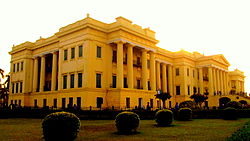Moorshedabad
| Murshidabad | |
|---|---|
| Town | |

The grounds of Hazarduari Palace, Murshidabad's most famous landmark
|
|
| Location in West Bengal | |
| Coordinates: 24°11′N 88°16′E / 24.18°N 88.27°ECoordinates: 24°11′N 88°16′E / 24.18°N 88.27°E | |
| Country |
|
| State | West Bengal |
| District | Murshidabad |
| Elevation | 10 m (30 ft) |
| Population (2011) | |
| • Total | 44,019 |
| Time zone | IST (UTC+5:30) |
| PIN | 74**** |
| Telephone code | 91-3472-2xxxxx |
| Lok Sabha constituency | Murshidabad |
| Vidhan Sabha constituency | Murshidabad |
| Website | murshidabad |
Murshidabad (Pron: ˈmʊəʃɪdəˌbɑ:d/bæd or ˈmɜ:ʃɪdəˌ) is a town in Murshidabad district of West Bengal state in India. The city of Murshidabad is located on the eastern bank of the Bhagirathi, a distributary of the Ganges River.
The District Of Murshidabad has an area of 2143 sq. m. It is divided into two nearly equal portions by the Bhagirathi, the ancient channel of the Ganges. The tract to the west, known as the Rarh, consists of hard clay and nodular limestone. The general level is high, but interspersed with marshes and seamed by hill torrents. The Bagri or eastern half belongs to alluvial plains of eastern Bengal. There are few permanent swamps; but the whole country is low-lying, and liable to annual inundation. In the north-west are a few small detached hillocks, said to be of basaltic formation.
Murshidabad was a town and district of British India, in the Bengal Presidency. In the Mughal period it was the capital of Bengal. The town of Murshidabad is on the left bank of the Hooghly River or main channel of the Ganges.
In 1704, Murshid Quli Khan, the Diwan of Bengal under Aurangzeb transferred the capital from Dacca (now Dhaka in Bangladesh), and renamed the city Murshidabad after his own name. In 1716, he attained the title of Nawab (ruler) of the Subah (province) of Bengal, and Murshidabad became his capital.
The family of Jagat Seth maintained their position as state bankers at Murshidabad from generation to generation. Even after the conquest of Bengal by the British, Murshidabad remained for some time the seat of administration. Warren Hastings removed the supreme civil and criminal courts to Calcutta in 1772, but in 1775 the latter courts were brought back to Murshidabad again. In 1790, under Lord Cornwallis, the entire revenue and judicial staffs were moved to Calcutta. The town was still the residence of the nawab, who ranked as the first nobleman of the province with the style of Nawab Bahadur of Murshidabad, instead of Nawab Nazim of Bengal. The Hazarduari Palace, dating back to 1837, is a magnificent building. The city still bears memories of Nawabs with other palaces, mosques, tombs, and gardens, and retains such industries as carving in ivory, gold and silver embroidery, and silk-weaving. A college was maintained for the education of the nawab's family. Rao Jogendra Narayan Roy king of Lalgola is remembered for his philanthropic work and charity.
...
Wikipedia

